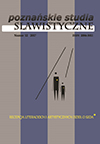Author(s): Hilarion Lehenky / Language(s): Ukrainian
Issue: 1/2015
The article provided cultural reconstruction style formation the twentieth century. Determined that nonconformism as a stage style dynamics shaping occurs in the context where culture or cultural practices reach "blossoming complexity" by Leontiev. In non-conformism intention incompleteness, incompleteness thoughts and redundancy imaginative innovation (synthesis of style artifacts) overflowing. It is proved that non-conformism is characteristic model configuration predetermined external display that always connects art with rules and models imitation behavior and immanent reality denial of these standards, providing a discourse that captures the flow changes, openness and incompleteness of creative innovation. In non-conformism style is a secondary phenomenon, because the non-reality tends to the creative eclecticism. Non-conformism – is no dichotomy alternatives, a conscious choice – creative thinking. Language, speech, discourse is always figurative, pictographic focus and cannot be abstractly defined. The discourse of non-conformism – is always incomplete image culture, are a symptom of incomplete permanent continuous formation of images, image, ideals and standards. Arts and signify this way as non-conformism purely artistic. So we fix two stages in the transition style formation – internal (non-conformism as immanent transformation blossoming complexity stationary style) and foreign – denial following the previous style, which takes place in the context of the stage of simple radical actions (fusion – Art Nouveau, demonstrations objection classical culture in the forefront; frakalnyh genetic algorithm searches micro intervals as denial culture of postmodernism in general). What is called "dialogue of cultures", "stylistic interaction" is at the stage of primary and secondary simplification cultures and their practices, which is a prerequisite not synthesis, symbiosis, and proper dialogue – preserve the authenticity of cultural artifacts. In style are created under: proto phase which defines metaphysical little principle shaping style as the previous final stylistic development; stage primary shaping simplicity of style that correlates with the simplicity of the style of the previous finals; flowering stage as excess complexity of a system that produces nonconforming intentions – the search for organic art systems; retrospective stage or second stage of simplification, which correlates with the stage of primary simplicity of style and produces denial stage of ease in the next style. If we are talking about non-conformism, then he characterized predetermined outer configuration model that always connects art with the rules and realities of those who create designs of imitation behavior. Difficulties stylistic interpretations are not only non-conformism that is hard to describe internal and external determinants, difficult to describe how one goes in a different style in the context of multi stylistic reality culture of the twentieth century. Artistic innovation of the twentieth century chronologically by avant-garde. Vanguard returned to the simple and clear configurations. This is the avant-garde, which itself represents a return to the stage poetics of the first prophets of the first analysts and synthetic vision as a world vanguard aesthetics. Phase vanguard nonconformity that occurs as a reflection and embodiment of avant-garde creative intuitions that require new (fractal) monism. At the forefront can see the different stages: the first stage, which is the following of modern intuitions Nouveau as a negation of antiquity, held in eclecticism, vidtvorylasya as a radical negation, negation of the entire classical culture, sharp break, demonstration of the world. In figurative art, architecture did not experience such a sharp breaking, as it happens in music. It may be noted that all the talk about symmetry, which helps to structure the twentieth century, a certain diversity of art practices as one big song is not productive. We are not trying to draw parallels between music and architecture Art Nouveau, our task – only to determine that modern non-conformism nose in a new model of budivnoyi design. It can be said that the style is not modern two stages: eclecticism and its own modernist style, but the third stage of primary simplicity (eclectic), stage and stage Nouveau dual simplification (retrospection, or so-called modern classicism). When it comes to modern style, it is often too formally define it as purely linear, focused on plastics plant type shaping. It is a style that existed in the late twentieth century until the First World War, according to a number of theorists on art, architecture, design. However – this is superficial and artificial interpretation style. Homelessness exist in space, devoid of big narratives, do adds nothing to understanding discourse nonconformity? Non-conformism (art, music) is an extremely versatile product culture, product multidimensional, synthetic, if not eclectic. However it is eclectic topic as guidance nonconformity is the closest to the value style. Stylistic features nonconformity difficult to specify because we have a discourse specifies located in marginal space. The discourse of non-conformism – is always incomplete image culture, are a symptom of incomplete permanent continuous formation of images, image, ideals and standards. That is not about the system and by the system characteristics that plunge man without a conscious or deliberate over the act and encourage artistic intuition and faith.
More...









